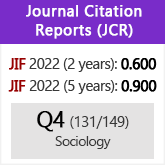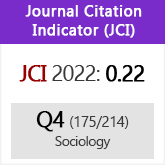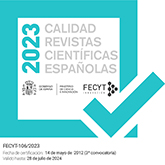From total institution to extitution? Discussions on the future of monastic life in the Benedictine women's monasteries of Catalonia (Spain)
DOI:
https://doi.org/10.3989/ris.2011.05.11Keywords:
Deinstitutionalisation, Extitution, Monastic life, Rule of Saint Benedict, Total institutionAbstract
On the 50th anniversary of the creation of the Federation of Benedictine Women’s Monasteries of Catalonia (Spain), the five monasteries represented are discussing the following question: what will monastic life be like in the future? This question is added to the debate about “new forms of monasticism”, “urban monastic life” and, in a more general sense, to the modernisations and “the opening up” of the precepts and practices of monastic life at this time. Faced with the ambitious monastic questioning, the author “responds” with five deliberately provocative debates developed out of a consideration of various chapters of the Rule of St. Benedict that raise profound questions when it comes to responding to the question presented here. Having described these five debates, by way of a summary, the article presents three ideal types of monastery in relation to the current processes of deinstitutionalisation that represent, in an overall way, three provisional responses and serve as a focus for the question discussed here.
Downloads
References
Bauman, Z. 2000. Liquid Modernity. Cambridge: Polity.
Bauman, Z. 2004. Identity. Cambridge: Polity.
Beck, U. 1992. Risk Society: Towards a New Modernity. London: Sage
Berger, P. L. 1992. A Far Glory: The Quest for Faith in an Age of Credulity. New York: The Free Press.
Berger, P. L. and Luckmann, T. 1966. The Social Construction of Reality: A Treatise on the Sociology of Knowledge. Garden City, NY: Anchor Books
Berger, P. L. and Luckmann, T. 1995. Modernity, Pluralism and the Crisis of Meaning: The Orientation of Modern Man. Gütersloh: Bertelsman Foundation Publishers
Calsina, M. 2009. “Nuevas formas urbanas de vida religiosa. Los dioses de la ciudad.” Metrópolis, 74.
Castells, M. 1996. The Information Age. Vol. 1. The Rise of the Network Society. London: Blackwell Publishing.
Chaves, M. 1997. Ordaining Women: Culture and Conflict in Religious Organizations. Cambridge-Mass: Harvard University Press.
Chittister, J. 2005. The Way We Were: A Story of Conversion and Renewal. London: Orbis Books.
Dubet, F. and Martucelli, D. 1998. Dans quelle société vivons-nous?. Paris: Seuil.
Dubet, F. 2002. Le déclin de l'institution. Paris: Seuil.
Elias, N. 1994. The Civilizing Process. Oxford: Blackwell.
Estruch, J. 1995. “La vida monástica en el hoy de la iglesia y el mundo.” Nova et Vetera nº 40:191-204.
Estruch, J. 2003. Sociología: la formación del grupo. Curia General del Orden Cistercense. http://www.cisterbrihuega.org/fondodoc/formacion/2003/esp/es_sociologia.pdf. Consultado el 20/02/2013.
Foucault, M. 1975. Surveiller et punir. Paris: Gallimard. PMid:1178450
Gergen, K. J. 1991. The Saturated Self. New York: Basic Books.
Goddijin, H.P.M. 1965. "Monastic community life in our times." Social Compass 12: 101-113. http://dx.doi.org/10.1177/003776866501200105
Goffman, E. 1961. Asylums: Essays on the Social Situation Mental Patients and Other Inmates. New York: Doubleday.
Goleman, D. 1995. Emotional Intelligence. New York: Bantam Books.
Hérvieu-Léger, D. 1999. Le pèlerin et le converti. La religion en mouvement. Paris: Flammarion.
Hervieu-Léger, D. 2003. Catholicisme, la fin d'un monde. Paris: Bayard.
Landron, O. 2004. Les Communautés nouvelles. Nouveaux visages du catholicisme français. Paris: Éd. du Cerf.
Longo, F. and Ysa, T. (eds.) 2007. Els escenaris de la gestió pública del segle XXI. Barcelona: Genera-litat de Catalunya.
Luckmann, T. 1967. The Invisible Religion. New York: Macmillan.
Luhmann, N. 1996. Social Systems. Palo Alto: Stanford University Press.
Maffesoli, M. 2004. El nomadismo. Vagabundeos iniciativos. Mexico: FCE.
Mayntz, R. 1998. “New challenges to governance theory.” Jean Monet Chair Paper RSC, No. 98/50.
Messner, D. 1997. The Network Society: Economic Development and International Competitiveness as Problems of Social Governance. London: Frank Cass.
Oviedo L. T. 2008. "The Effects of Organizational Culture on a Catholic Religious Order." Journal of Contemporary Religion 23, 2: 193-214. http://dx.doi.org/10.1080/13537900802024519
Panikkar, R. 1984. Blessed Simplicity: The Monk as a Universal Archetype. San Francisco, CA: Harper.
Palmisano, S. 2007. Le nuove comunità religiose in Piemonte. Torino: Rapporto di Ricerca “Progetto Alfieri.” Fondazione CRT.
Serres, M. 1994. Atlas. Paris: Julliard.
Tirado, F. J. and Domènech, M. 2001. “Extituciones: el poder y sus anatomias.” Política y Sociedad 36: 183-196.
Tyack, D. and Tobin, W. 1994. “The 'grammar' of schooling: why has it been so hard to change?” American Educational Research Journal 31 (3): 453-479.
Weber, M. 1964. The Sociology of Religion. Boston: Beacon. PMCid:2106452
Wittberg, P. 2006. From Piety to Professionalism and Back. Transformations of Organized Religious Virtuosity. New York-Toronto-Oxford: Lexington Books.
Wouters, C. 2003. “La civilisation des moeurs et des emotions: de la formalisation à l'informalization.” Norbert Elias et la théorie de la civilisation. Rennes: Presses Universitaires de Rennes.
Downloads
Published
How to Cite
Issue
Section
License
Copyright (c) 2013 Consejo Superior de Investigaciones Científicas (CSIC)

This work is licensed under a Creative Commons Attribution 4.0 International License.
© CSIC. Manuscripts published in both the printed and online versions of this Journal are the property of Consejo Superior de Investigaciones Científicas, and quoting this source is a requirement for any partial or full reproduction.All contents of this electronic edition, except where otherwise noted, are distributed under a “Creative Commons Attribution 4.0 International” (CC BY 4.0) License. You may read here the basic information and the legal text of the license. The indication of the CC BY 4.0 License must be expressly stated in this way when necessary.
Self-archiving in repositories, personal webpages or similar, of any version other than the published by the Editor, is not allowed.

















